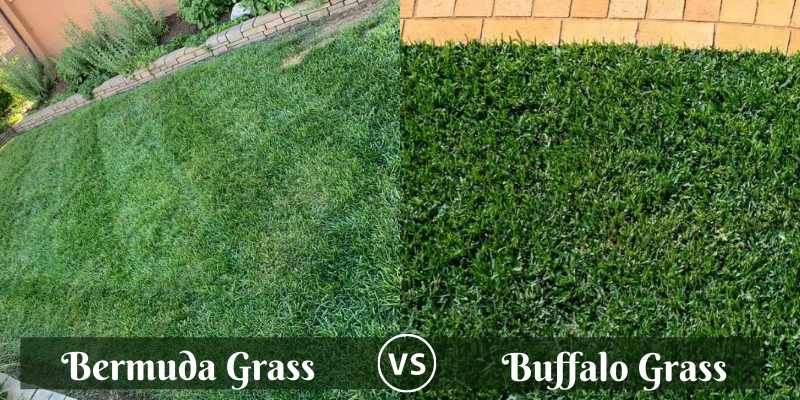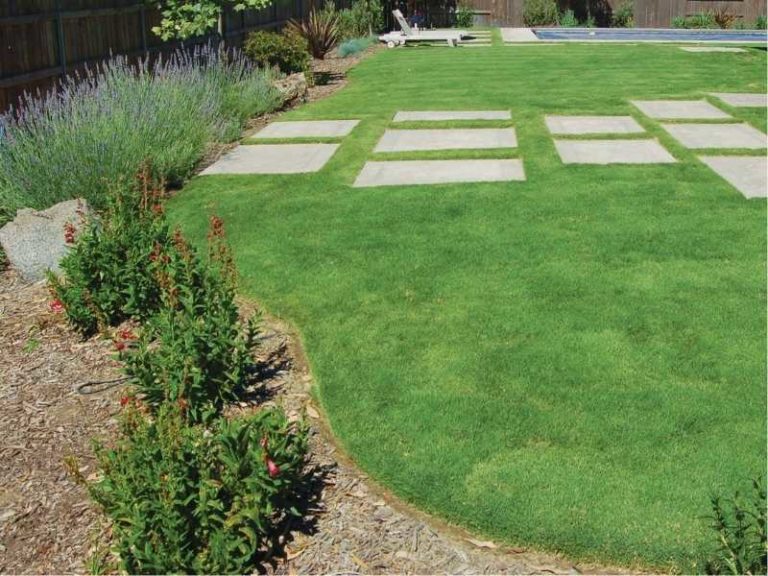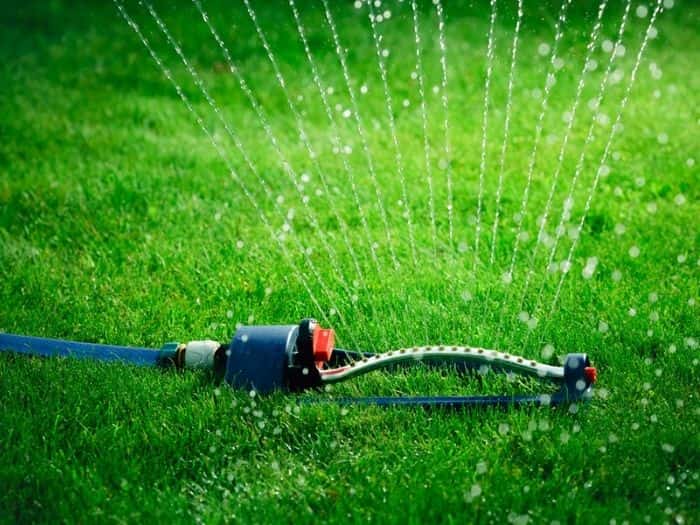Buffalo Grass Vs. Bermuda Grass
Lush green expanses are a landscaper’s dream. So, finding the right grass is crucial. Buffalo grass and bermuda grass are excellent choices that tick off most boxes of what you’d want on your lawn. These warm-season grasses are common in many lawns in the southern parts of the US. You’re also likely to find them thriving in tropical and subtropical regions.
While they’re excellent picks for a lawn, they are vastly different. Buffalo grass is the kind of grass you establish in any region, and you can be sure it’ll thrive. However, bermuda grass is stiff grass that can easily take over the entire lawn.
Either of these grasses has its pros and cons. We get down to the roots to help you choose the best grass for your lawn.
What is buffalo grass?
Buffalo grass (Bouteloua dactyloides) is a perennial warm-season grass native to the Great Plains from Montana to Mexico.
Buffalo grass has grayish-blue, fine-textured leaves which fall towards the ground, giving the grass its short appearance. The leaf blades are sharp-pointed, flat, and sparsely-haired. The grass has stolons but no rhizomes.
Buffalo grass establishes from seeds, sods, and plugs. However, the seeds are expensive, especially if you plan on covering large areas. The grass sets slowly, taking two years to be ready for use.
Buffalo grass prefers areas with well-drained, heavy loamy clay soils with a pH of 6.0 to 8.0. It moderately tolerates saline soils. The grass deteriorates in areas with loose sandy soils.
Buffalo grass has the best tolerance to cold despite being warm-season grass. It goes dormant in winter and turns brown in extreme cold. However, it greens up in spring.
Buffalo grass thrives in areas with total sun exposure of 6 to 8 hours daily and doesn’t tolerate shade. It does well in moderate traffic areas but heavy traffic will wear it down.
Buffalo grass grows in dry areas receiving 15 to 30 inches of water annually. However, it performs poorly in areas with less than 15 inches annually and regions with high rainfall. In drier areas, the grass goes dormant and becomes vulnerable to weeds.
You’d have a hard time growing buffalo grass in high-rainfall areas. Additionally, you’d have to deal with the invasion of weeds and tall grasses such as fescues and Bermuda grass. Furthermore, overly wet areas weaken buffalo grass, making it susceptible to diseases such as brown leaf spots.
Buffalo grass is a low-maintenance grass and suffers if overmanaged. The low-growing grass needs infrequent mowing when actively growing in summer. Mowing the grass once per month to about 2 to 3 inches is enough to keep it green and attractive. Mow buffalo grass lawn once per year in natural landscapes.
Buffalo grass thrives with no or minimal fertilizer application. Buffalo grass needs less than 2 pounds of Nitrogen fertilizer annually when actively growing. Make the first application of 1 pound per 1000 square feet in late May to mid-June and the second in late July.
Buffalo grass has good tolerance to heat and drought. It only needs infrequent deep watering. The grass has deep, dense roots that reach the soil water table to draw water to sustain it during harsh conditions. Irrigate the grass with one to two inches of water every four weeks in summer.
Buffalo grass is more susceptible to grassy and broadleaf weeds such as dandelions, crabgrass, and foxalis invasions. The grass is more vulnerable when young or when overwatered and overfertilized. Commercial selective herbicides control the weeds and avoid damaging the grass. Pre-emergent herbicides prevent weed seeds from growing when establishing a new lawn.
Buffalo grass has excellent disease resistance but is vulnerable to chin bugs and brown leaf spots. Control brown leaf spots by watering the grass when it needs water and growing it in areas with moderate rainfall. Pests such as white grubs, buffalo webworm, and grasshopper are common in buffalo grass. Fungicides are an effective measure against the pests problem, though.

What is bermuda grass?
Bermuda grass (Cynodon species) is a warm-season perennial grass native to Africa and is used as turfgrass and forage. However, it is considered an invasive weed in northern lawns.
Common bermuda grass (Cynodon dactylon) and C. transvaalensis are the most popular species. Bermuda grass features prominently in golf courses, tennis courts, athletics fields, and lawns.
Bermuda grass is a dark-green, dense, sod-forming turf. Where undesired, bermuda grass forms conspicuous large patches of grass. The leaf blades are sparsely-haired or hairy, depending on the species. The ligule also has hairs. Bermuda grass inflorescence seedhead produces 3 to 7 finger-like spikes arranged in a single whorl. The spike has 2 to 3 mm long spikelets. The leaf sheaths are compressed, round, and smooth or sparsely haired. Bermuda grass has no auricles. The collar is continuous and hairy at the margins.
Bermuda grass thrives in moist, well-drained fertile soils with a pH of 6.0 to 6.5. it also tolerates saline conditions.
Bermuda grass prefers full sun and performs poorly in shades.
Average annual rainfall of about 25 to 100 inches is sufficient to grow healthy Bermuda grass. Irrigation is necessary for areas with lower than 20 inches of water annually.
Bermuda grass establishes by sods, plugs, and seeds. The grass grows fast and spreads by above-ground stems called stolons or runners, underground stems called rhizomes, and seeds. The rhizomes extend fast laterally to cover bare spots or areas with thin turf on the lawn. Bermuda grass highly outcompetes weeds in Bermuda grass yards but is a tough weed to remove where undesired.
Bermuda grass withstands heavy traffic. It makes excellent turfgrass in lawns with kids and pets always playing. Suppose it wears, it recovers quickly.
Bermuda grass tolerates extreme heat and prolonged drought because its dense roots penetrate the soil beneath to draw water from the water table.
Bermuda grass has a high fertilizer requirement of about 4 pounds of nitrogen per 1000 square feet applied throughout summer. Bermuda grass grows tall to about 4-12 inches if left uncut. Mow the grass between 1 to 2 inches, depending on the species in your lawn.
Buffalo grass Vs. Bermuda grass
Buffalo grass and Bermuda grass are great warm-season turfs for southern lawns because they stand the heat and prolonged drought in those areas. However, they have distinct features from appearance and reaction to different lawn problems.
The table below summarizes the differences between buffalo grass and bermuda grass.
| Buffalo grass | Bermuda grass |
| Has grayish-blue leaves | Has a light to dark green leaves |
| Sharp pointed, sparsely haired, or flat-leaf blades | Sparsely or haired leaf blades |
| Leaves alternate along the stolon | Leaves are opposite each other |
| Rolled vernation | Folded vernation |
| Tolerates moderate traffic | Tolerates high traffic |
| Less durable | More durable |
| Requires less often mowing | Requires frequent mowing |
| Low nitrogen content needs | High nitrogen content needs |
| More vulnerable to weeds | Less vulnerable to weeds |
Leaf color
Buffalo grass has grayish-blue leaves, while Bermuda grass has light to dark-green leaves, depending on the species.
The leaf blades of Buffalo grass are sharply pointed, sparsely-haired, and flat. Meanwhile, bermuda grass leaf blades are haired or sparsely haired, depending on the species.
Buffalo grass leaf blades alternate along the stolons, and only the leaves at the tip are paired. Meanwhile, bermuda grass leaf blades emerge opposite each other along the stem.
The type of vernation
Buffalo grass has a rolled vernation, while Bermuda grass has a folded vernation.
New young leaves of Buffalo grass emerge rolled from the bud.
On the other hand, in bermuda grass, new young leaves appear folded from the bud.
The durability
Bermuda grass is more durable than Buffalo grass.
Buffalo grass is a perennial warm-season grass that has existed for years on the lawn once established.
Conversely, Bermuda grass is also a perennial warm-season grass but exists longer on the lawn than Buffalo grass once established.
Tolerance to traffic
Buffalo grass tolerates low to moderate traffic, while Bermuda grass withstands heavy traffic.
Buffalo grass makes perfect grass for low-traffic lawns. Its slow recovery and vulnerability to heavy traffic make it ideal as ornamental grass.
Meanwhile, Bermuda grass survives on lawns with heavy foot traffic without getting injured. It shows impressive recovery from damage.
Maintenance needs
Buffalo grass is a low-maintenance grass, while Bermuda grass is higher maintenance.
Buffalo grass needs less watering, fertilizing, and mowing to grow healthy. Buffalo grass is low-growing thus cut once monthly in summer. The grass thrives with no fertilizer application and tolerates less than 2 pounds of nitrogen per 1000 square feet annually.
Conversely, Bermuda grass requires frequent mowing and high-nitrogen content. The grass grows fast in summer and is thus cut once or twice weekly, depending on the species. Bermuda grass has high fertilizer need of more than 4 pounds of nitrogen fertilizer per 1000 square feet in summer to grow green and healthy.
Vulnerability to weeds
Buffalo grass is more vulnerable to weeds, while Bermuda grass is less vulnerable to weeds.
Grassy and broadleaf weeds such as dandelion, crabgrass, and foxalis are prevalent in Buffalo grass lawns. Buffalo grass establishes slowly, enabling weeds and other tallgrass species to invade the property. Buffalo grass becomes inferior in high rainfall above 30 inches and overfertilized areas, paving the way for weeds.
Meanwhile, Bermuda grass establishes and spreads fast. It out-competes other weeds and is invasive in northern lawns. The stolon and rhizome spread it to cover bare and thin spots in the yard faster than other grasses and weeds, thus making it more competitive.
Can I mix buffalo grass and bermuda grass?
You cannot mix buffalo grass and bermuda grass on the same lawn since they have different watering needs. Bermuda grass becomes invasive in areas with high rainfall, while buffalo grass becomes inferior.
The Bermuda grass grows faster and overruns the lawn. Meanwhile, Bermuda grass suffers in drier areas with extreme heat and drought, yet Buffalo grass thrives in the same conditions.
Buffalo vs. bermuda grass, which is better?
Bermuda grass performs better than buffalo grass in most settings. Bermuda grass forms a dense, dark green attractive lawn. It highly resists pests and diseases and outcompetes grassy and broadleaf weeds. The grass also tolerates high foot traffic and quickly recovers when injured.
Reference
Clemson University: Bermuda grass.






